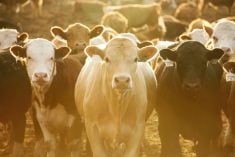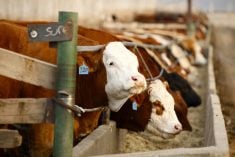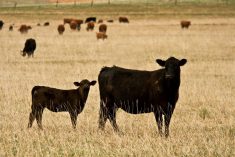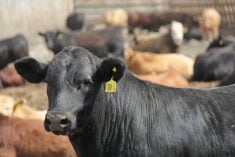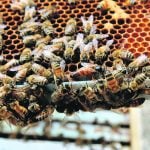Western Canadian feeder cattle prices were relatively unchanged from week-ago levels. The major feeding regions from Alberta to the U.S. Midwest and southern Plains have all experienced severe storms and extreme temperatures. The forecast for southern Alberta calls for lows of -25 to -32 C over the next seven days. Auction markets have a few local buyers but everyone is shy of transporting cattle farther distances and settling feeders into a new environment. Alberta margins remain in negative territory and feedlots cannot afford to have cattle stagnate for extended periods.
Read Also

U.S. grains: Soy futures post biggest monthly gain in nearly five years on China trade optimism
U.S. soybean futures climbed to a 15-month high and posted their biggest monthly gain in nearly five years on Friday following a rally fueled by the prospect of revived exports to China.
In central Alberta, Simmental larger-frame fleshier steers averaging 925 lbs. were valued at $175; in central Saskatchewan, tan mixed heavier-flesh steers averaging 840 lbs. were quoted at $180, while similar-quality larger-frame mixed heifers weighing 830 lbs. traded for $167. Heavier replacements in the non-major feeding areas were $3-$5 lower this week. In Manitoba, tan mixed steers weighing just over 850 lbs. were quoted at $174, while Hereford blended fleshier steers averaging 880 lbs. sold for $169.
Temperatures didn’t seem to faze buyers searching for grass cattle while backgrounding operators were on the sidelines. Finishing feedlots don’t want to be pushing “intense care” calves into the custom backgrounding lot under these weather conditions. Buyers of grass cattle thought they would take advantage of the limited competition but there was virtually no slippage in the market. Much of Western Canada has received record snowfall during February, so pastures will be in excellent shape come spring.
In southern Alberta, black steers averaging 660 lbs. were quoted at $205; in Manitoba, Charolais mixed steers weighing 665 lbs. were valued at $203. Small groups of steers weighing 500-550 lbs. in central Alberta were rather hot, with prices reported from $232 to as high as $240. There were some bragging rights in Manitoba with a group of 580-lb. Charolais steers quoted at $230. Even a priest lies about his car’s gas mileage but there is no doubt about it, these lighter calves are hard to buy at this time of year.
— Jerry Klassen manages the Canadian office of Swiss-based grain trader GAP SA Grains and Produits Ltd. and is president and founder of Resilient Capital, specializing in proprietary commodity futures trading and market analysis. Jerry consults with feedlots on risk management and writes a weekly cattle market commentary. He can be reached at 204-504-8339.




